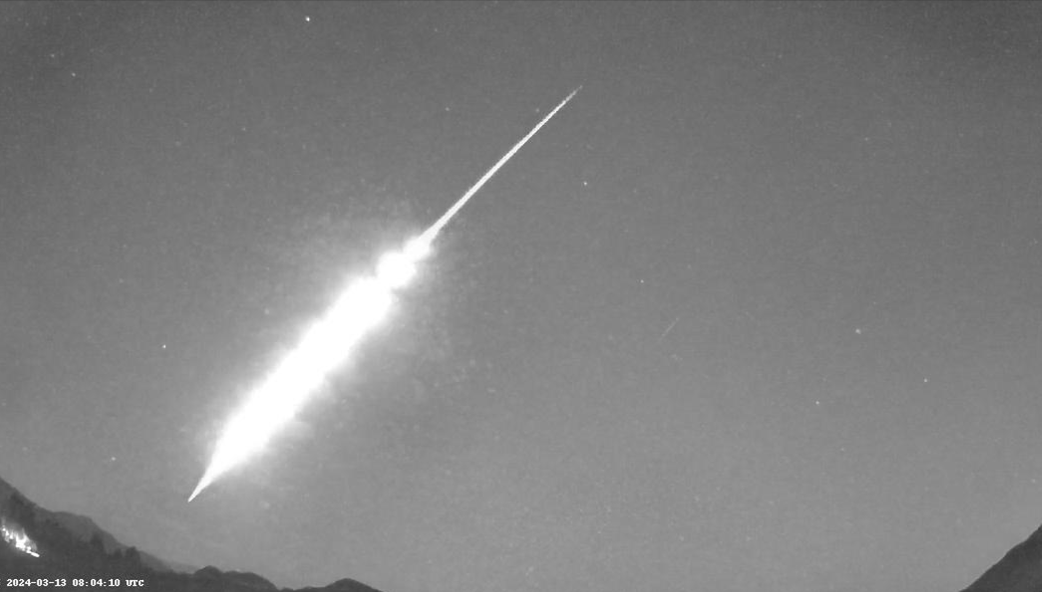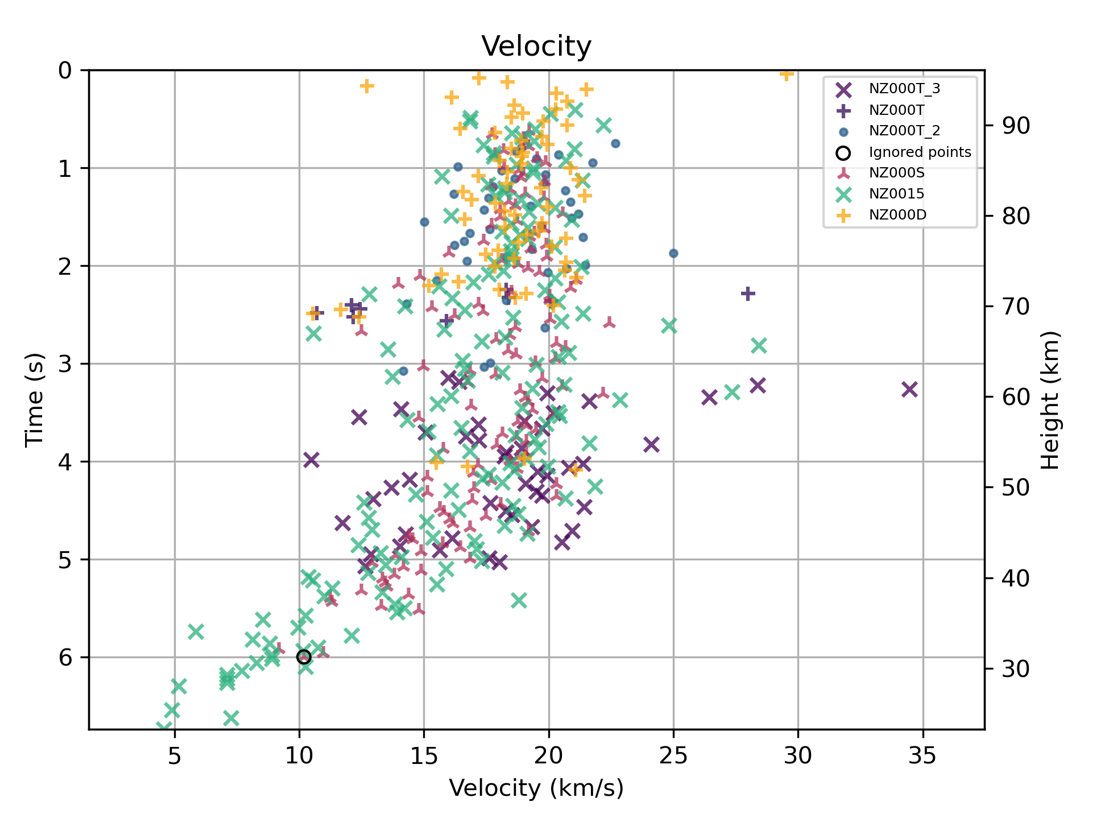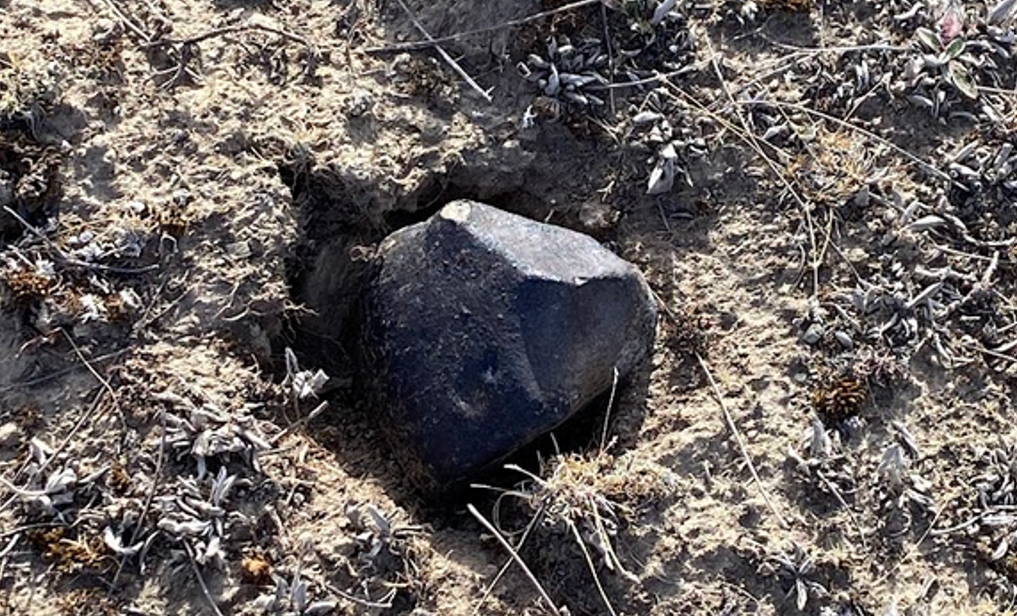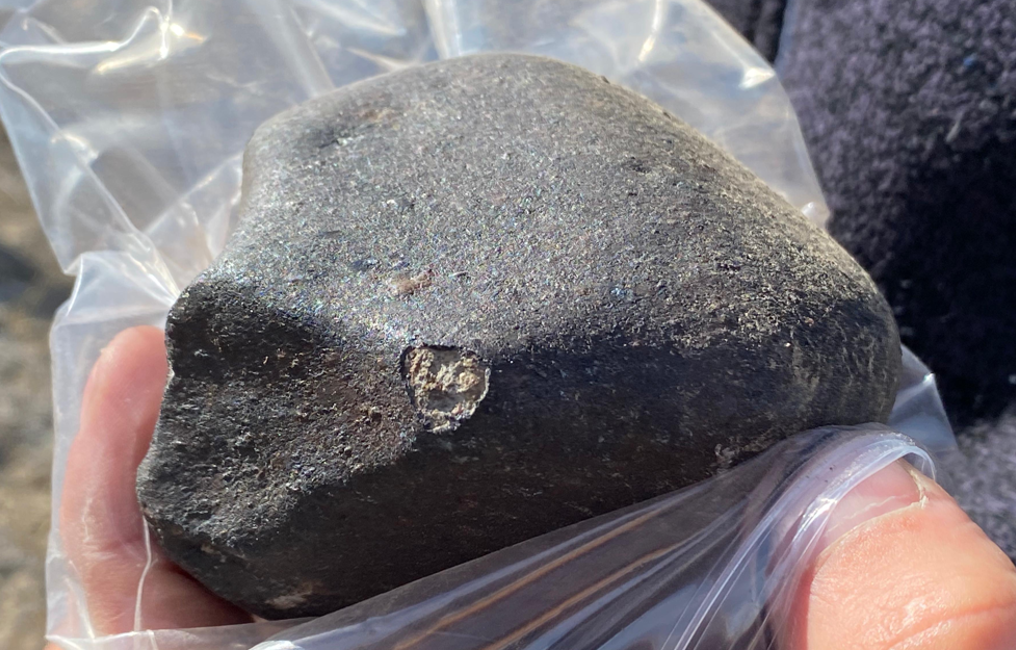By James M. Scott, Denis Vida, Dennis Behan, Mia R. Boothroyd, Daniel L. Burgin, David Grieg, Peter McKellar, Marshall C. Palmer, Terry Richardson, Jim Rowe, Damir Segon , Jesse Stayte , Thomas Stevenson, Tingting Wang, Jack Weterings, Steve Wyn-Harris
Abstract: At 9.04 pm on the evening of March 13th 2024, a fireball shot across the South Island of New Zealand. The combined fireball path was calculated from 90 to 25 km elevation by four camera stations, which showed that it decelerated from 18 km/s to 5 km/s. The dark flight model and Monte Carlo simulation for the main mass resulted in a strewn field in the Tekapo/Takapō region of the central South Island, and an 810 gm fusion-encrusted stoney meteorite was recovered within 30 minutes of initiation of the public search.
Introduction
New Zealand’s meteor camera network, known as Fireballs Aotearoa (www.fireballs.nz), comprises over 120 Raspberry Pi Meteor Station (RMS) cameras and one Allsky7 camera (Fig. 1). The cameras are mounted in schools, observatories and with the public. The goals of this non-commercial and citizen science network are to aid the discovery of New Zealand’s next meteorite, feed into global meteor shower observations, and engage the public in night-sky observations. Recovered meteorites will be characterised and then donated to a national museum.

Figure 1. New Zealand’s meteorite camera network.
The network has been active for just over two years and has achieved near total coverage of the night-sky above the country down to 25 km elevation, which is critical for observing endpoint of meteorite-dropping fireballs. The Southern Hemisphere position makes it an important global component in detecting meteor showers (e.g., Segon et al., 2022; Roggemans et al., 2024; Jenniskens, 2024), which are not well studied as Northern Hemisphere showers. On Dec 12th 2023, for example, the New Zealand network led the detection of a new meteor shower called lambda-Sculptorids, which was produced by comet 46P/Wirtanen (Roggemans et al., 2024; Vida et al., 2024). However, despite several fireballs possibly dropping small meteorites and a one multi-day coordinated search for a 10 kg possible iron meteorite in 2022, no meteorites had been recovered using camera data until now.
March 13th fireball
At 9.04 pm local time on March 13th, an impressive fireball was seen crossing the sky above Otago and Canterbury. It was caught beautifully on an Allsky7 camera (www.allsky7.net; Hankey et al., 2020) and the first eyewitness report was from Dennis Behan, who was sitting in his hot tub at the time. Fortuitously, it also was captured by his personal Global Meteor Network (www.globalmeteornetwork.com; Vida et al., 2021) meteor camera, NZ0015 (Fig. 2). Using data from NZ0015, NZ000T (Fiordland College, Te Anau), NZ000S (Maniototo Area School, Ranfurly), and NZ000D (Oamaru North, Oamaru) the trajectory, velocity and origin of this fireball were determined by McKellar, Stayte and Vida. NZ0044 (Livingstone, Otago) also captured the fireball, but clouds in the region at the time inhibited using this data.

Figure 2. Fireball captured by NZ0015 at Arthurs Point, Queenstown. This also the approximate view from the hot tub.
Trajectory
Modelling of the trajectory using Skyfit2 indicated that the fireball was visible for 6.72 seconds, during which it descended from 96 km to about 23.3 km elevation (Fig. 3). It began to rapidly decelerate at 50 km elevation from an initial velocity of about 18 km/s and was traveling at only 5 km/s at 23.3 km. Upon reaching this point, the fireball stage ended and the remaining mass, which was estimated to be between 0.6 to 1.6 kg for an ordinary chondrite-type meteorite, with the nominal mass of 0.9 kg, fell towards the surface of the Earth.

Figure 3. Velocity and time of the fireball, as determined from NZ000S, D, T and 15.
Using weather station data from Invercargill, a dark flight solution by Vida and Stayte had the rock falling on an old braided river channel associated with the Tekapo River in public Department of Conservation land south of the township of Tekapo. The name of this town is after the adjacent lake, which was known as Takapō by the Maori. This area is famous for its giant salmon, views of New Zealand’s highest mountain, and being a location for the Lord of the Rings movie series.
Field search
A reconnaissance search of a portion of the strewn-field was undertaken three days later (on the 16th) by Behan and Palmer. This showed that the prospective area was flat, little vegetated and that the ground was hard-packed as a result of drought. Following a significant media blitz, a public search led by Behan, Palmer and Wyn-Harris set out on the 20th of March and remarkably what is thought to be the main mass meteorite was recovered within 30 minutes of the search initiation within the strewn field. The finder, Jack Weterings from Wellington, noticed the meteorite partially embedded in the ground and immediately recognised it to be distinct from the surround flood-plain greywacke gravels (Fig. 4). The good cell-phone coverage in the area meant that he could immediately send a photograph to Palmer to examine.

Figure 4. The meteorite resting in the crater.
The recovered meteorite has a thin black fusion crust and a slightly unusual shape on one flank where it has lost a substantial bit of the rock, possibly late in the fireball stage. The fusion crust was chipped on one surface due to impact with the ground, and reveals a pale interior that – at the time of writing – looks similar to the colour and texture of a metamorphosed ordinary chondrite (Fig. 5). The chipped fragments could not be located. Following positive visual identification, a handheld portable x-ray fluorescence device was used to analyse the rock through a plastic bag. This revealed high Ni concentrations. The rock now awaits further study led by the University of Otago Department of Geology.

Figure 5. The fusion crust is chipped and displays a pale coloured interior.
Discussion and conclusions
This is New Zealand’s 10th confirmed meteorite, and the first in 20 years. It is also only the second one in which a fireball was first seen and then the rock rapidly recovered – the other being the CV3 Mokoia (Marriner, 1910). There was a daytime ordinary chondrite fall (Auckland) in 2004 but no fireball was reported (Scott et al., 2023). The largest New Zealand meteorite was the 50 kg Dunganville (Challis 1984) and the previous smallest was the ~1 kg Auckland.
Our calculations show that the object had an Aten-type orbit, with the perihelion just inside the orbit of Venus and the aphelion just outside the orbit of the Earth (Fig. 6). Only a handful of meteorites are observed to arrive on such orbits. This will be examined in more detail in the future, along with the composition of the rock and its cosmic-ray exposure age, as orbits in this part of the Solar System are not dynamically stable over long periods of time. Thus, the new meteorite, likely to be named Tekapo, confirms the ability of the Fireballs Aotearoa meteor camera network to accurately and rapidly aid meteorite recovery, and will hopefully provide further insights into the history of the Solar System.

Figure 6. The calculated orbit of the rock that formed the meteor is shown in green. Earth is blue, Venus is yellow.
Acknowledgments
With great thanks, we acknowledge the searchers: S. Adam, A. Barrajun, W Chang, S. Eberlin, E. Gapper, E. Gapper, M. Gapper, Z. Gapper, A. Gilmore, P. Gilmore, T.Y. Lin, S. Robb, G. Rocord, P. Silva, R. McCarthy, M. Midgley, A. Muner, M. Stroinigg, H. Williams, M. Williams, S. Wilson and M.Ying.
We also greatly acknowledge all the NZ meteor camera hosts, who have contributed to the project: M. Anderson, S. Baker Wilson, E. Balks, E. Barraclough, H. Barker, J.-F. Barrois, A. Barron, C. Beaman, D. Behan, T. Bell, M. Boothroyd, R. Brady, A. Brickell, K. Browne, R. Brunton, M. Camilleri, L. Carpenter, R. Carstens, J. Cheetham, M. Clare, F. Cole, D. Colthorpe, S. Cooke-Willis, D. Cowan, K. Christie, J. Critchley, A. Crowther, R. Croy, N. Davies, R. Dickie, L. Dowling, R. Elias-Drago, J. Drummond, A. Emerson, B. Evans, A. Fastier, K. Faure, P. Felhofer, R. Frazer, M. Forbes, A. Fox, A. Fuller, L. Gilbert, D. Godsiff, B. Goodwill, P. Graham, D. Greig, B. Hagen, C. Haines, B. Hasson, J. van Hattum, D. Hickey, L. Holstein, M. Hope, G. Hudson, R. Idaczyk, N. Izsett, P. Jaquiery, C. Jones, C. Jones, A. Johnston, D. Johnson, K. Johnston, M. Kennedy, S. Land, S. Leaske, S. Lewis, J. McCulloch, T. McGirrt, G. McKay, P. McKeller, H. McKinnon, T. McMahon, D. McNamara, S. McMillan, F. McNaught, A. Mason, S. Matheson, S. Oosterman, G. Palmer, M. Palmer, G. Parker, J. Parkinson, H. Petelo, N. Peterson, S. Peterson, N. Powell, R. Querel, B. Reid, J. Richards, T. Richardson, A. Robertson, L. Robertson, B. Rowe, J. Russell, C. Sale, C. Sara, A. Scott, Y. Scott, M. Singleton, N. Simmonds, R. Skilton, J. Stayte, P. Stewart, J. Taylor, B. Thomas, J. Thompson, M. Thompson, S. Tonorio, T. Vowles, M. Ward, R. Welch, N. Wiffen, J. Williams, S. Wyn-Harris, C. Young, J. Zani, C. Zink.
We especially acknowledge: Sirko Molau and Mike Hankey of www.allsky7.net for helping build and then enabling Allsky7 camera 247; a Participatory Science Platform Grant associated with the NZ Curious Minds, which was administered by the Otago Museum; the Royal Astronomical Society of New Zealand; the Geoscience Society of New Zealand; the Raspberry PI Ltd, and two anonymous doners. Jack acknowledges TS for the guitar pick given to him by the lead guitarist, which was with him on the search and which he believes was instrumental in finding the meteorite.
References
Challis, G. A. (1984). The Dunganville (New Zealand) meteorite: an iron octahedrite (Note). New Zealand Journal of Geology and Geophysics, 27(3), 391-393.
Jenniskens, P. (2024) Enhanced iota-Centaurids (ICN#919) activity in 2024. eMeteorNews, 9, 53-54
Marriner G.R.. (1910) The Mokoia Aerolite; with a few introductory remarks on New Zealand meteoric Phenomena. Transactions and proceedings of the Royal Society of New Zealand, 42, 176-185
Roggemans, P., Vida, D., Scott, J. M., Jenniskens, P., Šegon, D., & Rollinson, D. (2024). First observed meteors from comet 46P/Wirtanen (lambda-Sculptorids, LSC). eMeteorNews, 9(1), 6-14.
Šegon, D., Vida, D., Roggemans, P., Wood, J., Boothroyd, M., Fraser, R., Hanigan, G., Poulton, D., Scott, G., Scott, J. and Zink, C., 2023. 2023 activity omega-Carinids (OCR# 1033). eMeteorNews, (2), pp.74-76.
Scott, J. M., Negrini, M., Faure, K., Palmer, M. C., Knaack, D. R., & Leybourne, M. I. (2023). Multi‐zone fusion crust formation and classification of the 2004 Auckland meteorite (L6, S5, and W0). Meteoritics & Planetary Science, 58(3), 328-340.
Vida, D., J. M. Scott, A. Egal, J. Vaubaillon, Q-Z. Ye, D. Rollinson, M. Sato, and D. E. Moser. “Observations of the new meteor shower from comet 46P/Wirtanen.” Astronomy & Astrophysics 682 (2024): L20.

